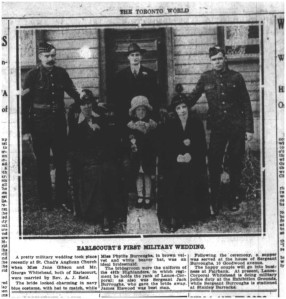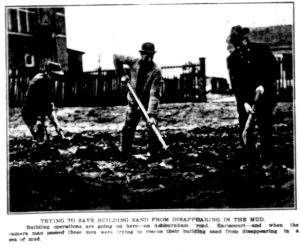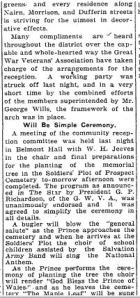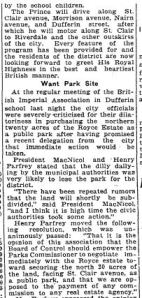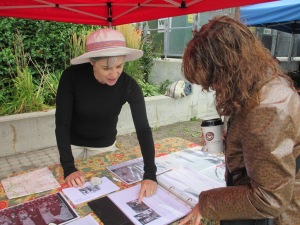Still basking in the glory of the empire, Torontonians’ connection to the “old country” in the years around the Great War was close and sentimental. Playing to this loyalty, the British Imperial Association (B.I.A.), a group of northwest suburban ratepayers born in the British Isles, successfully lobbied City Council for infrastructure, services and employment for their 1910-annexed district. Toronto passed the half million population mark when it expanded its boundaries. In the competitive shuffle for a greater share of the public purse, the B.I.A. gave the Earlscourt district an important edge.
 F 1244 S 2119 it 38.43 Earlscourt Triple Wedding 1910
F 1244 S 2119 it 38.43 Earlscourt Triple Wedding 1910
A single (February 11, 1915) issue of The Weekly Times, a local newsletter published by the B.I.A. survives in the Henry Parfrey Fonds of the City of Toronto Archives. Celebrating the fourth year of its existence, the Association takes credit for the recent appearance or official promise of sidewalks, fire station, lights, police protection, a library and a park through its deputations to city authorities. The newsletter casts a wide net for the work of the B.I.A. associating it with the neighbourhoods of Oakwood, Wychwood, Earlscourt, Silverthorn, Fairbank, Caledonia and Avenue Road.
Balanced with its coverage of local affairs, The Weekly Times featured news culled from letters sent home by Earlscourt men at the front. In the back pages, English football scores and recipes for such Anglo working class treats as Lemon Cream Sherbet and Potato Biscuits are shared. Bird fanciers/aspiring poultry farmers are offered advice on how to set up a small operation in one’s yard, reflecting the prevalence of small-scale farming activity in the area.
Shack town
Photographs by William James published in The Toronto Star Weekly documented the rugged hinterland that was the Earlscourt-Fairbank district. The captions pronounced that the area was on the rise after the recent years of struggle, a testament to the sobriety, industry and organization of its civic-minded residents.
 “Building Up a Great City Development in the Heart of Toronto and in it Outskirts” The Toronto Star Weekly March 14, 1914, p. 9
“Building Up a Great City Development in the Heart of Toronto and in it Outskirts” The Toronto Star Weekly March 14, 1914, p. 9
A TYPICAL SCENE IN EARLSCOURT—HARVIE AVENUE LOOKING NORTH. Harvie avenue is the final street east of Prospect Cemetery and runs north from St. Clair avenue. It is here shown where it has run north of the city limit—away beyond older Earlscourt. The small but neat solid brick houses being built to replace shacks, the board sidewalks, the water and mud, go to make a typical Earlscourt scene.
NORTH EARLSCOURT—A CONTINUATION OF OLDER EARLSCOURT—A TORONTO WORKING MAN’S DISTRICT WHICH HAS DEVELOPED IN A WAY TO ASTONISH EVEN A WESTERN PIONEER. A panoramic view of North Earlscourt looking north from the top of Harvie avenue. The development of older Earlscourt was wonderful but this is a new wonder. The arrow on the skyline to the right is the little North Earlscourt Methodist Church which was blown down by the recent great storm but which had already been put together again by the energetic people of this congregation before this picture was taken.
OAKWOOD HALL, A MEETING PLACE OF PIONEERS ON THE TORONTO FRONTIER. This little public hall in Fairbank, once a village now merged in North Earlscourt is used for all kinds of gatherings. Outside is a slate for announcements. When this picture was made the slate announced a Conservative meeting. Older boards announced Methodist Church services and Methodist Brotherhood meetings and ratepayers meetings.
CLUBHOUSE OF THE NORTH EARLSCOURT RATEPAYERS’ PROTECTIVE SOCIETY. The Earlscourt residents have always had a strong sense of citizenship and away on the distant borders of North Earlscourt stands this clubhouse where the North Earlscourt Ratepayers’ Protective Society holds regular meetings. As can be judged by its appearance, the clubhouse was built by the members in their spare time, just as many of the houses of the district were built.
Notorious for the cheaply constructed temporary housing from which it derived its “Shack town” nickname, Earlscourt was a place of fire, famine and disease-prone winters. The suffering peaked during the years of high unemployment just before the war when city authorities were still scrambling to set up an effective web of firefighting and public health stations to service the breadth of its territory. The Star‘s coverage of the district focused on residents’ drive for success in the face of considerable obstacles.
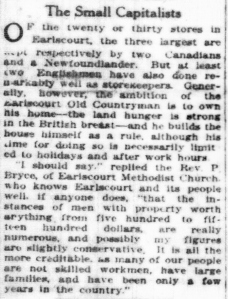 “Earlscourt Shackers Now Becoming…” The Toronto Star Weekly Jan 18, 1913
“Earlscourt Shackers Now Becoming…” The Toronto Star Weekly Jan 18, 1913
The Unsinkable Earlscourtonians
 CTA F 2114 it 17.34 child stuck in mud helped by a friend
CTA F 2114 it 17.34 child stuck in mud helped by a friend
Appreciating how the spring and fall mud affected all movement in the district’s streets, James’ trained his camera to reveal telling incidents both comic and tragic. The physical drama of coping with impassable mud and its symbolic corollary, the heroic struggle to transcend the quagmire of poverty, these were the visual emblems of Earlscourt relayed to the public through the pages of The Toronto Star Weekly.
 “Spring in Open Country and in Toronto’s Muddy Suburbs”, Toronto Star Weekly April 5, 1913
“Spring in Open Country and in Toronto’s Muddy Suburbs”, Toronto Star Weekly April 5, 1913
The Empire and the Working Man
Membership in the B.I.A. was reserved for those born in the British Isles and control over the association’s agenda was firmly in the hands of the executive committee and leader Henry Parfrey. The Caledonia chapter dissolved in 1914 citing as problems the domination of the central, Earlscourt group as well as the reluctance of area residents to join a group with such a strongly political name. “People,” said Secretary Riley, “object to the name British Imperial Association. They think it has some political significance and are unwilling to join, though it would be easy to obtain a large number of members for a straight ratepayers’ association.” (“B.I.A. Disbanding” The Star April 22, 1914)
 Goad’s Fire Map 1910 Wards 6 & 7
Goad’s Fire Map 1910 Wards 6 & 7
Henceforth the Earlscourt Imperial Association would drop its district title, purporting to represent the north western suburban region of the city. Along with Reverend Bryce of the Central Methodist Church, Henry Parfrey of the B.I.A. provided essential community leadership. But while the former confined himself to organizing charity, social and religious activity, the latter took on government and big business, avowedly fighting on behalf of the un-recognized dues of the working “Brit”, backbone of the Empire.
Reverend Peter Bryce's Bible class, Boon Avenue Methodist Church, Earlscourt, Toronto ca. 1920 (Parfrey seated second from left, second row)
Along with vociferous protests against any rate increase, the refrain of the British Imperial Association was that the City gave preferential treatment to “foreigners” in their area’s public works projects. Front-of-the-line treatment on the 1912-13 St. Clair streetcar line construction and 1914 Bathurst Hill grading was felt by members’ to be their proper entitlement. With the beating of the war drums coinciding with the 1914 municipal elections, prominent candidate Thomas Foster unrolled his xenophobic, protectionist platform before an approving B.I.A. audience. Neatly encapsulating the contemporary prejudice against outsiders who chose high-density living conditions above the celebrated pioneering impulse fueling suburban sprawl, Foster laid it on the line:
Alluding to the unemployment problem, ex-Controller Foster emphasized what he has contended at other meetings, that there were obligations on the Dominion and the Provincial Governments as well as the city to provide work at this critical period. He further stated that the pioneers of this country were Britishers from the British Isles, not foreigners. They were doing more for industry than all the foreigners that could be brought from any country. They knew the way these foreigners were herded together, their cheap form of living, and it was not fair competition for the Britisher to contend with men who lived like that. “Foster Drops Out To Save Trouble” Globe, Dec. 22, 1914 p. 22
Royal Visit
Earlscourt’s media darling status was consolidated by reports of the area’s disproportionate war losses. The 1919 Prince of Wales visit to the area completed the ugly duckling to swan narrative. Rumours that the stop in the northwest suburb would not be part of itinerary because it was too unsightly for royal scrutiny caused dismay among Torontonians. Earlscourt had been elevated to a living monument representing the nation’s pioneering past.
Earlscourt has every reason to be proud of its pioneer origin and the shack that was once its distinguishing characteristic. As a Canadian farmer if he is ashamed of the fact that his grandfather was a pioneer and lived in a log hut!… Of course the shack has now disappeared as the log hut did, but both are enshrined in the hearts of the men today as symbols of hard work and homely heroism.“Honor to the Shacks” Star, letter to the Editor, Aug. 14, 1919 p.6
The Prince’s visit focused on a memorial ceremony in Prospect Ceremony, linking its grounds to the memory of the Great War for future residents of the district.
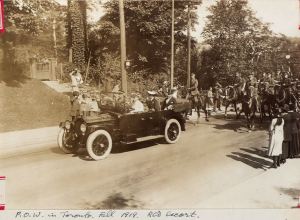 Prince of Wales, Toronto 1919, Toronto Public Library
Prince of Wales, Toronto 1919, Toronto Public Library
Waves of Pioneers
The identity of the Earlscourt-Fairbank district was forged at the moment when all the newly annexed suburban areas were in hot competition for city resources. Earlscourt had the advantage of the unrelenting lobbying by the B.I.A. along with the press-led popular view that its residents embodied the spirit of Canada’s pioneers. The Gallery of Portuguese Pioneers that exists today on the north side of St. Clair avenue just west of Oakwood echoes the epic narrative of immigration and celebrates just one of the many subsequent settlement waves that have left their imprint on Earlscourt.
Further Reading
Unplanned Suburbs, Toronto’s American Tragedy, Richard Harris


